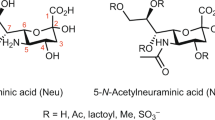Abstract
Acidic O-glycans having sialic acid and/or sulfate residue are abundantly expressed in intestinal mucins. However, structural elucidation of acidic O-glycans is a laborious and time-consuming task due to their large structural variations. Here, we describe a methodology of structural elucidation for sialylated O-glycan alditols from intestinal mucins using tandem mass spectroscopy. Methylesterification and mild periodate oxidation of sialylated O-glycan alditols assist mass analysis. This description includes the purification process of O-glycan alditols for structural analysis.
Access this chapter
Tax calculation will be finalised at checkout
Purchases are for personal use only
Similar content being viewed by others
References
Holmén Larsson JM, Thomsson KA, Rodríguez-Piñeiro AM et al (2013) Studies of mucus in mouse stomach, small intestine, and colon. III. Gastrointestinal Muc5ac and Muc2 mucin O-glycan patterns reveal a regiospecific distribution. Am J Physiol Gastrointest Liver Physiol 305:G357–G363
Tsubokawa D, Ishiwata K, Goso Y et al (2015) Induction of Sd(a)-sialomucin and sulfated H-sulfomucin in mouse small intestinal mucosa by infection with parasitic helminth. Exp Parasitol 153:165–173
Iwai T, Ichikawa T, Goso Y et al (2009) Effects of indomethacin on the rat small intestinal mucosa: immunohistochemical and biochemical studies using anti-mucin monoclonal antibodies. J Gastroenterol 44:277–284
Saegusa Y, Ichikawa T, Iwai T et al (2008) Changes in the mucus barrier of the rat during 5-fluorouracil-induced gastrointestinal mucositis. Scand J Gastroenterol 43:59–65
Kawashima R, Fujimaki M, Ikenoue Y et al (2016) Influence of an elemental diet on 5-fluorouracil-induced morphological changes in the mouse salivary gland and colon. Support Care Cancer 24:1609–1616
Tsubokawa D, Goso Y, Sawaguchi A et al (2007) A monoclonal antibody, PGM34, against 6-sulfated blood-group H type 2 antigen, on the carbohydrate moiety of mucin. FEBS J 274:1833–1848
Tsubokawa D, Goso Y, Kawashima R et al (2012) The monoclonal antibody HCM31 specifically recognises the Sd(a) tetrasaccharide in goblet cell mucin. FEBS Open Bio 2:223–233
Powell AK, Harvey DJ (1996) Stabilization of sialic acids in N-linked oligosaccharides and gangliosides for analysis by positive ion matrix-assisted laser desorption/ionization mass spectrometry. Rapid Commun Mass Spectrom 10:1027–1032
Chai W, Stoll MS, Galustian C et al (2003) Neoglycolipid technology: deciphering information content of glycome. Methods Enzymol 362:160–195
Dubois M, Gilles KA, Hamilton JK et al (1956) Colorimetric method for determination of sugars and related substances. Anal Chem 28:350–356
Ishihara K, Kameyama J, Hotta K (1993) Development of an HPLC method to estimate hexosamines and its application to determine mucin content in rat and human gastric mucosa. Comp Biochem Physiol B 104:781–786
Kamerling JP, Vliegenthart JFG (1992) High-resolution 1H-nuclear magnetic resonance spectroscopy of oligosaccharides released from mucin-type O-glycoproteins. Biol Magn Reson 10:1–287
Ishihara K, Kurihara M, Goso Y et al (1996) Peripheral alpha-linked N-acetylglucosamine on the carbohydrate moiety of mucin derived from mammalian gastric gland mucous cells: epitope recognized by a newly characterized monoclonal antibody. Biochem J 318:409–416
Acknowledgements
The authors express our sincere appreciation to S. Sugawara for her technical assistance.
Author information
Authors and Affiliations
Corresponding author
Editor information
Editors and Affiliations
Rights and permissions
Copyright information
© 2024 The Author(s), under exclusive license to Springer Science+Business Media, LLC, part of Springer Nature
About this protocol
Cite this protocol
Tsubokawa, D., Kawashima, R., Ichikawa, T. (2024). Structural Elucidation of Sialylated O-Glycan Alditols Obtained from Mucins by Mass Spectrometry. In: Kameyama, A. (eds) Mucins. Methods in Molecular Biology, vol 2763. Humana, New York, NY. https://doi.org/10.1007/978-1-0716-3670-1_18
Download citation
DOI: https://doi.org/10.1007/978-1-0716-3670-1_18
Published:
Publisher Name: Humana, New York, NY
Print ISBN: 978-1-0716-3669-5
Online ISBN: 978-1-0716-3670-1
eBook Packages: Springer Protocols




